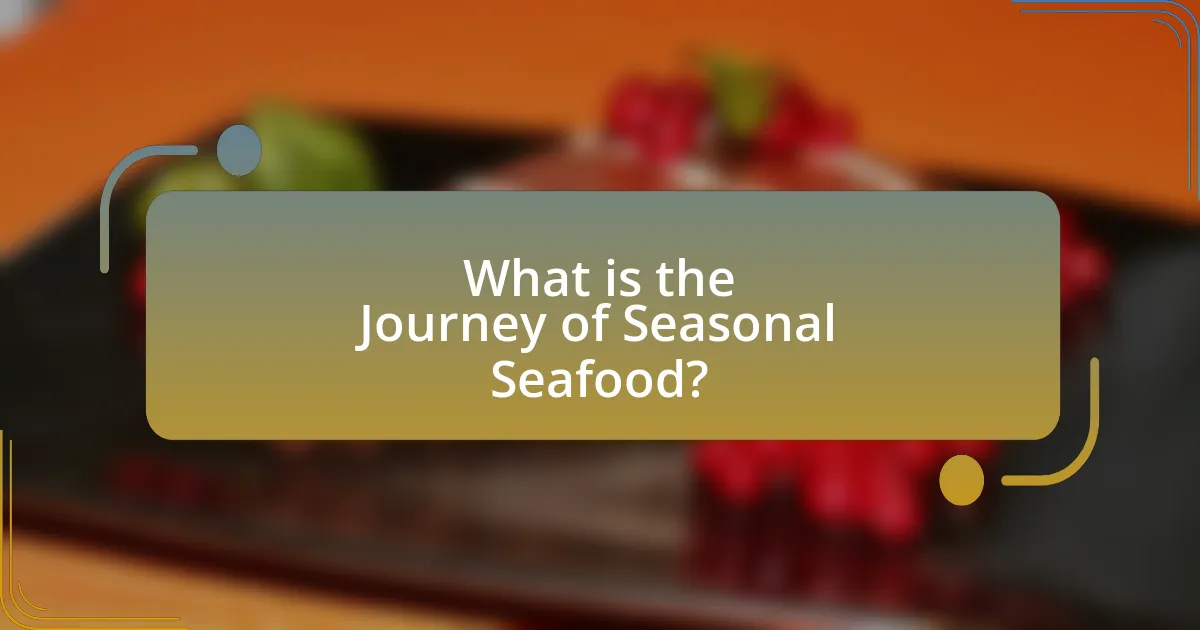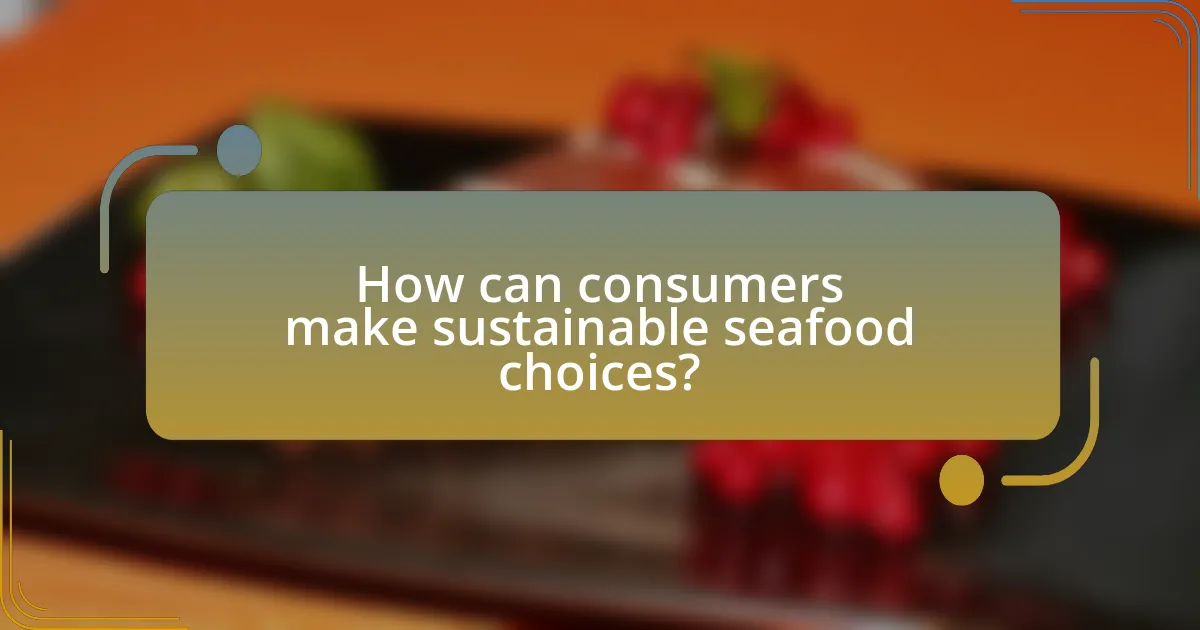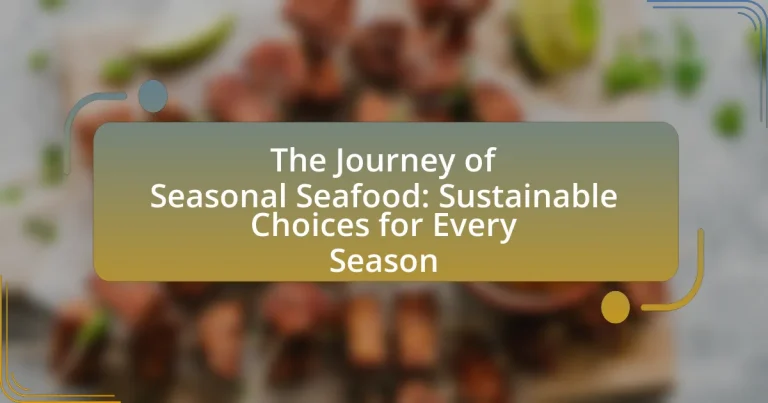The article “The Journey of Seasonal Seafood: Sustainable Choices for Every Season” explores the significance of seasonal seafood in promoting sustainability and enhancing quality. It details how the natural life cycles of marine species dictate their availability, emphasizing the importance of responsible fishing practices to maintain fish populations and support local economies. Key factors defining seasonal seafood, such as breeding cycles and environmental conditions, are discussed, along with the nutritional advantages and environmental impacts of overfishing. The article also provides practical tips for consumers on how to make sustainable seafood choices, identify certified products, and incorporate seasonal seafood into their meals.

What is the Journey of Seasonal Seafood?
The journey of seasonal seafood begins with the natural life cycles of marine species, which dictate their availability based on seasonal changes. For example, certain fish spawn in specific months, making them more abundant and sustainable to catch during those times. This seasonal availability is crucial for maintaining fish populations and supporting local fishing communities. Sustainable fishing practices, such as catch limits and seasonal closures, are implemented to ensure that seafood is harvested responsibly, allowing ecosystems to thrive. Research indicates that consuming seafood in alignment with its natural seasonality not only promotes sustainability but also enhances flavor and quality, as fish caught during their peak season are often fresher and more nutritious.
How does the concept of seasonal seafood influence sustainability?
The concept of seasonal seafood significantly influences sustainability by promoting the consumption of fish and shellfish that are harvested during their natural spawning cycles. This practice helps maintain fish populations and ecosystems, as it reduces overfishing and allows species to reproduce effectively. For instance, the Marine Stewardship Council reports that adhering to seasonal harvesting can lead to healthier marine environments and more resilient fish stocks, which are crucial for long-term sustainability. By aligning seafood consumption with seasonal availability, consumers can support responsible fishing practices that contribute to the overall health of ocean ecosystems.
What are the key factors that define seasonal seafood?
The key factors that define seasonal seafood include the species’ breeding cycles, environmental conditions, and fishing regulations. Breeding cycles dictate when certain seafood is most abundant, as many species spawn during specific times of the year, leading to peak availability. Environmental conditions, such as water temperature and salinity, also influence the presence of seafood in particular seasons. Additionally, fishing regulations, which are often established to protect overfished species, determine when and how much seafood can be harvested, further defining the seasonal availability of various seafood types. For example, many fisheries implement closed seasons to allow fish populations to recover, aligning with their natural reproductive cycles.
How does seasonal availability affect seafood quality?
Seasonal availability significantly affects seafood quality by influencing factors such as freshness, flavor, and nutritional content. When seafood is harvested during its peak season, it is typically fresher and more flavorful due to optimal growth conditions, which enhance its taste and texture. For example, fish like salmon are known to have higher fat content and better flavor when caught during their spawning season, which occurs in late summer to early fall. Additionally, seafood that is out of season may be sourced from distant locations, leading to longer transportation times and potential degradation in quality. Studies have shown that seafood quality declines rapidly after harvest, with freshness being a critical determinant of overall quality. Therefore, consuming seafood in alignment with its seasonal availability ensures higher quality and better taste.
Why is sustainability important in seafood choices?
Sustainability is important in seafood choices because it ensures the long-term health of marine ecosystems and the viability of fish populations. Overfishing and destructive fishing practices can lead to the depletion of species, disrupting food chains and harming biodiversity. For instance, according to the Food and Agriculture Organization, approximately 34% of global fish stocks are overfished, which highlights the urgent need for sustainable practices. By choosing sustainably sourced seafood, consumers support responsible fishing methods that protect habitats and promote the recovery of fish populations, thereby contributing to ecological balance and food security.
What are the environmental impacts of overfishing?
Overfishing leads to significant environmental impacts, primarily the depletion of fish populations and disruption of marine ecosystems. When fish are removed from their habitats at unsustainable rates, it results in a decline in biodiversity, as many species rely on each other for ecological balance. For instance, overfishing of predator species can lead to an increase in prey species, which may then overconsume their own food sources, causing further ecological imbalance. According to the Food and Agriculture Organization, approximately 34% of global fish stocks are overfished, which underscores the urgency of addressing this issue to maintain marine health and sustainability.
How do sustainable practices benefit marine ecosystems?
Sustainable practices benefit marine ecosystems by promoting biodiversity and enhancing the resilience of marine habitats. These practices, such as responsible fishing methods and habitat protection, help maintain healthy fish populations and prevent overfishing, which can lead to ecosystem collapse. For instance, the implementation of marine protected areas has been shown to increase fish biomass by up to 600% in some regions, thereby supporting a diverse range of marine life. Additionally, sustainable aquaculture reduces the pressure on wild fish stocks and minimizes habitat destruction, contributing to the overall health of marine ecosystems.

What are the seasonal seafood options available throughout the year?
Seasonal seafood options available throughout the year include various species that peak in different seasons. In winter, options like cod, haddock, and oysters are abundant. Spring brings in soft-shell crabs, halibut, and salmon. Summer features shrimp, tuna, and clams, while fall offers scallops, mackerel, and lobster. These seasonal variations are influenced by breeding cycles and environmental conditions, ensuring sustainability and freshness. For example, the availability of salmon is highest in late spring and early summer, aligning with their spawning season, which supports responsible fishing practices.
How do seafood varieties change with the seasons?
Seafood varieties change with the seasons due to factors such as water temperature, breeding cycles, and migration patterns. For instance, certain fish species like salmon are more abundant in summer when they migrate upstream to spawn, while shellfish like oysters are typically harvested in colder months to ensure better quality and taste. Additionally, seasonal availability is influenced by fishing regulations that aim to protect overfished species, ensuring sustainable practices. This cyclical pattern of seafood availability aligns with ecological and environmental conditions, making it essential for consumers to adapt their choices based on the season.
What types of fish are best consumed in spring?
Salmon, trout, and sardines are the types of fish best consumed in spring. Salmon is particularly abundant during this season as it migrates upstream to spawn, making it fresh and flavorful. Trout, especially rainbow and brook trout, are also in season and are known for their delicate taste and high omega-3 fatty acid content. Sardines, which are typically caught in spring, offer a sustainable option due to their rapid reproduction rates and are rich in nutrients. These fish not only provide health benefits but also align with sustainable seafood practices during the spring season.
Which shellfish are in season during summer months?
During the summer months, shellfish such as clams, oysters, and shrimp are in season. Clams are typically harvested from late spring through early fall, while oysters are best enjoyed in warmer months, particularly from May to September, as they spawn during this period. Shrimp, especially the Gulf shrimp, are abundant and widely available during summer, peaking in production. This seasonal availability is supported by fisheries management practices that align harvesting with the natural life cycles of these species, ensuring sustainability and quality.
What are the benefits of choosing seasonal seafood?
Choosing seasonal seafood offers numerous benefits, including enhanced freshness, better taste, and environmental sustainability. Seasonal seafood is typically harvested at its peak, ensuring optimal flavor and texture, which can significantly improve the dining experience. Additionally, selecting seafood that is in season supports local fisheries and reduces the carbon footprint associated with transportation, as it often requires less travel compared to out-of-season options. Furthermore, consuming seasonal seafood helps maintain fish populations and ecosystems, as it aligns with natural breeding cycles, promoting sustainable fishing practices. This approach not only benefits consumers but also contributes to the health of marine environments.
How does seasonal seafood contribute to local economies?
Seasonal seafood significantly contributes to local economies by boosting employment and generating revenue through fishing, processing, and tourism. The fishing industry creates jobs for local fishermen and supports ancillary businesses such as bait shops and equipment suppliers. For instance, in coastal regions, seasonal seafood harvesting can lead to increased sales in local markets and restaurants, which rely on fresh, locally sourced products. According to the National Oceanic and Atmospheric Administration (NOAA), commercial fishing in the United States generated approximately $5.6 billion in revenue in 2020, highlighting the economic impact of seafood on local communities. Additionally, seasonal seafood attracts tourists, further enhancing local economies through spending on accommodations, dining, and recreational activities.
What nutritional advantages does seasonal seafood offer?
Seasonal seafood offers enhanced nutritional advantages, including higher levels of omega-3 fatty acids, vitamins, and minerals. These nutrients are more abundant in seafood that is harvested during its peak season, as fish and shellfish are typically more active and feeding on nutrient-rich diets. For instance, studies indicate that wild-caught salmon, when in season, contains significantly higher omega-3 content compared to farmed alternatives, which can be lower in these essential fats due to diet differences. Additionally, seasonal seafood is often fresher, leading to better preservation of nutrients, making it a healthier choice overall.

How can consumers make sustainable seafood choices?
Consumers can make sustainable seafood choices by selecting seafood that is certified by reputable organizations such as the Marine Stewardship Council (MSC) or the Aquaculture Stewardship Council (ASC). These certifications indicate that the seafood is sourced from fisheries or farms that adhere to environmentally responsible practices. According to the MSC, certified fisheries must demonstrate sustainable fish populations, minimize environmental impact, and ensure effective management practices. Additionally, consumers can consult resources like the Seafood Watch program, which provides recommendations based on sustainability criteria, helping individuals choose seafood that supports healthy ocean ecosystems.
What guidelines should consumers follow when selecting seafood?
Consumers should follow guidelines that prioritize sustainability, freshness, and safety when selecting seafood. To ensure sustainability, consumers should look for seafood certified by organizations like the Marine Stewardship Council or the Aquaculture Stewardship Council, which indicate responsible fishing and farming practices. Freshness can be assessed by checking for clear eyes, firm flesh, and a mild ocean smell; these indicators suggest the seafood is recently caught. Additionally, consumers should avoid seafood from overfished stocks, which can be verified through resources like the Seafood Watch program, which provides updated lists of sustainable seafood choices. Following these guidelines helps support healthy ocean ecosystems and ensures the seafood is safe for consumption.
How can consumers identify sustainably sourced seafood?
Consumers can identify sustainably sourced seafood by looking for certifications from reputable organizations such as the Marine Stewardship Council (MSC) or the Aquaculture Stewardship Council (ASC). These certifications indicate that the seafood has been sourced in a manner that maintains fish populations and minimizes environmental impact. Additionally, consumers can consult seafood guides from organizations like the Monterey Bay Aquarium, which provide recommendations based on sustainability assessments. Research shows that seafood with these certifications is more likely to be harvested responsibly, ensuring the long-term health of marine ecosystems.
What role do certifications play in seafood sustainability?
Certifications play a crucial role in seafood sustainability by providing a standardized framework that ensures seafood products are sourced responsibly and sustainably. These certifications, such as the Marine Stewardship Council (MSC) and the Aquaculture Stewardship Council (ASC), assess fisheries and aquaculture operations against rigorous environmental and social criteria. For instance, MSC-certified fisheries must demonstrate sustainable fish populations, minimal environmental impact, and effective management practices. This verification process helps consumers make informed choices, promotes responsible fishing practices, and encourages industry stakeholders to adopt sustainable methods, ultimately contributing to the preservation of marine ecosystems.
What are some practical tips for incorporating seasonal seafood into meals?
Incorporating seasonal seafood into meals can be achieved by selecting fish and shellfish that are at their peak during specific times of the year. For instance, during spring, opt for species like halibut and soft-shell crabs, while summer is ideal for enjoying tuna and shrimp. Utilizing local seafood markets or community-supported fisheries ensures freshness and supports sustainable practices. Additionally, planning meals around seasonal seafood can enhance flavor; for example, pairing grilled salmon with summer vegetables or using clams in a hearty winter chowder. Research indicates that consuming seafood in season not only promotes better taste but also contributes to sustainable fishing practices, as it aligns with the natural breeding cycles of fish populations.
How can meal planning help in choosing seasonal seafood?
Meal planning aids in choosing seasonal seafood by providing a structured approach to incorporate fresh, locally available options into diets. This practice encourages consumers to research and select seafood that is in season, which is often more sustainable and flavorful. For instance, seafood like salmon is typically in season during summer months, while cod is more abundant in winter. By aligning meal plans with these seasonal patterns, individuals can support local fisheries and reduce the environmental impact associated with out-of-season seafood sourcing.
What are some easy recipes featuring seasonal seafood?
Easy recipes featuring seasonal seafood include grilled salmon with lemon and herbs, shrimp stir-fry with seasonal vegetables, and baked cod with a breadcrumb topping. Grilled salmon is prepared by marinating the fish in lemon juice, olive oil, and fresh herbs before cooking it on a grill for about 6-8 minutes per side. Shrimp stir-fry involves sautéing shrimp with seasonal vegetables like bell peppers and snap peas in a hot pan with soy sauce for 5-7 minutes. Baked cod is made by coating the fish with breadcrumbs mixed with garlic and parsley, then baking it at 400°F for 15-20 minutes. These recipes utilize seasonal seafood, ensuring freshness and sustainability.


